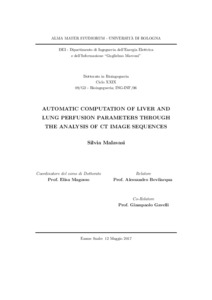Malavasi, Silvia
(2017)
Automatic Computation of Liver and Lung Perfusion Parameters through the Analysis of CT Image Sequences, [Dissertation thesis], Alma Mater Studiorum Università di Bologna.
Dottorato di ricerca in
Bioingegneria, 29 Ciclo. DOI 10.6092/unibo/amsdottorato/8188.
Documenti full-text disponibili:
![[img]](http://amsdottorato.unibo.it/8188/1.hassmallThumbnailVersion/AUTOMATIC%20COMPUTATION%20OF%20LIVER%20AND%20LUNG%20PERFUSION%20PARAMETERS%20THROUGH%20THE%20ANALYSIS%20OF%20CT%20IMAGE%20SEQUENCES.pdf)  Anteprima |
|
Documento PDF (English)
- Richiede un lettore di PDF come Xpdf o Adobe Acrobat Reader
Disponibile con Licenza: Salvo eventuali più ampie autorizzazioni dell'autore, la tesi può essere liberamente consultata e può essere effettuato il salvataggio e la stampa di una copia per fini strettamente personali di studio, di ricerca e di insegnamento, con espresso divieto di qualunque utilizzo direttamente o indirettamente commerciale. Ogni altro diritto sul materiale è riservato.
Download (41MB)
| Anteprima
|
Abstract
Computed Tomography perfusion (CTp) is a promising technique for early assessment of the effectiveness of the new anti-angiogenic therapies for cancer treatment. Nonetheless, some difficulties to achieve standardized results in the examinations have slowed down its application in the daily clinical practice. This Thesis addresses three important open issues: a lack of methods to measure results reliability, the clinical relevance of the global perfusion parameter values commonly utilised, a critical revision of protocols of the multi-centre studies. In this work, lung and liver CTp examinations were considered, being among the most studied sites in oncology.
First, I set up and validated an error index capable to measure the quality of perfusion results. After that, structured regions affected by noise (e.g., artefacts), vessels or bronchi have been looked for on whole slices. Also exploiting a new error index, an adaptive algorithm has allowed detecting and excluding all those regions automatically.
The common practice in CTp perfusion studies is providing one averaged value only for each perfusion parameter, computed on the whole tumour, to reduce data variability, but at the expense of tumour heterogeneity. Accordingly, whole lung lesions were considered to inquire into the clinical representativeness of global perfusion values. After proposing a statistical index to quantify tumour functional heterogeneity, it has been proved that using one global value even misleads clinical considerations.
The last part of the Thesis regards the activities carried out in the widest European multi-centre study on liver CT. Some algorithms to improve the accuracy of perfusion results were developed to favour comparisons of multi-centre CTp examinations. Some meaningful results regarding baseline and blood flow values of liver are discussed, highlighting whether different CT scanners affect CTp outcomes. Finally, tentative guidelines are provided to help considering all the concealable sources of heterogeneity in advance, before planning the protocols.
Abstract
Computed Tomography perfusion (CTp) is a promising technique for early assessment of the effectiveness of the new anti-angiogenic therapies for cancer treatment. Nonetheless, some difficulties to achieve standardized results in the examinations have slowed down its application in the daily clinical practice. This Thesis addresses three important open issues: a lack of methods to measure results reliability, the clinical relevance of the global perfusion parameter values commonly utilised, a critical revision of protocols of the multi-centre studies. In this work, lung and liver CTp examinations were considered, being among the most studied sites in oncology.
First, I set up and validated an error index capable to measure the quality of perfusion results. After that, structured regions affected by noise (e.g., artefacts), vessels or bronchi have been looked for on whole slices. Also exploiting a new error index, an adaptive algorithm has allowed detecting and excluding all those regions automatically.
The common practice in CTp perfusion studies is providing one averaged value only for each perfusion parameter, computed on the whole tumour, to reduce data variability, but at the expense of tumour heterogeneity. Accordingly, whole lung lesions were considered to inquire into the clinical representativeness of global perfusion values. After proposing a statistical index to quantify tumour functional heterogeneity, it has been proved that using one global value even misleads clinical considerations.
The last part of the Thesis regards the activities carried out in the widest European multi-centre study on liver CT. Some algorithms to improve the accuracy of perfusion results were developed to favour comparisons of multi-centre CTp examinations. Some meaningful results regarding baseline and blood flow values of liver are discussed, highlighting whether different CT scanners affect CTp outcomes. Finally, tentative guidelines are provided to help considering all the concealable sources of heterogeneity in advance, before planning the protocols.
Tipologia del documento
Tesi di dottorato
Autore
Malavasi, Silvia
Supervisore
Co-supervisore
Dottorato di ricerca
Ciclo
29
Coordinatore
Settore disciplinare
Settore concorsuale
Parole chiave
Image processing, signal analysis, quantitive imaging, biomedical imaging, multi-centre study, cancer
URN:NBN
DOI
10.6092/unibo/amsdottorato/8188
Data di discussione
12 Maggio 2017
URI
Altri metadati
Tipologia del documento
Tesi di dottorato
Autore
Malavasi, Silvia
Supervisore
Co-supervisore
Dottorato di ricerca
Ciclo
29
Coordinatore
Settore disciplinare
Settore concorsuale
Parole chiave
Image processing, signal analysis, quantitive imaging, biomedical imaging, multi-centre study, cancer
URN:NBN
DOI
10.6092/unibo/amsdottorato/8188
Data di discussione
12 Maggio 2017
URI
Statistica sui download
Gestione del documento:


 Login
Login
